Crayfish are fascinating aquatic creatures that can really add to your home aquarium. Their resilience and adaptability make them especially appealing to beginners in the hobby. Yet, finding the right tank mates to accompany these intriguing creatures can be a puzzle.
In this article, we’ll simplify that task, guiding you through top choices and ensuring a balanced and harmonious underwater community. Join us as we explore the best companions for your crayfish!
1. Brown Pencilfish (Nannostomus eques)
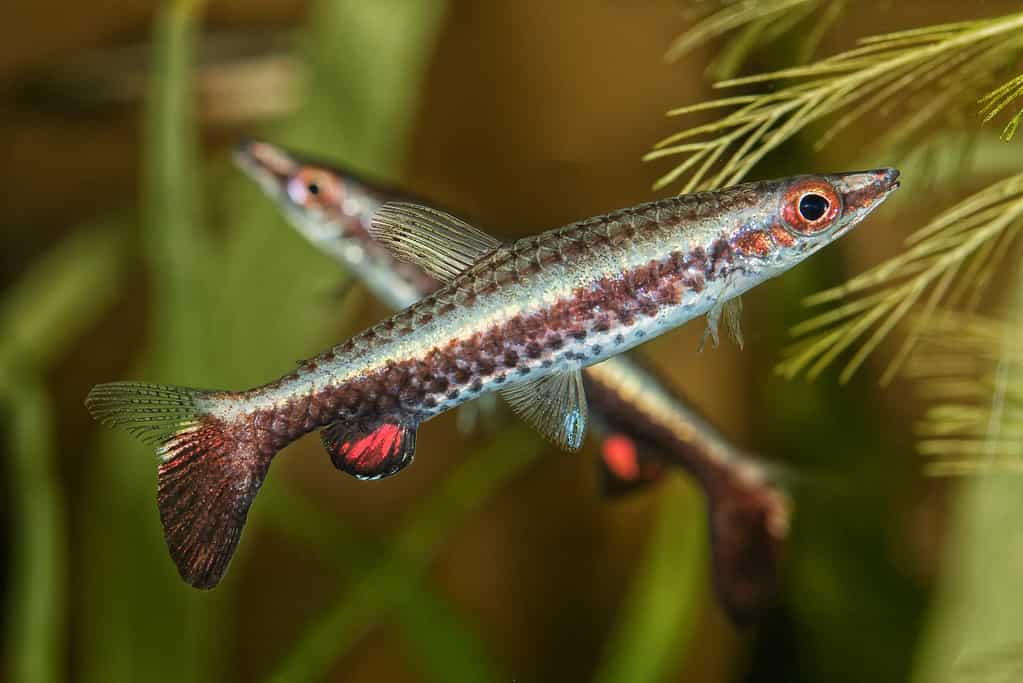
The brown pencilfish is a small and beautiful freshwater aquarium fish.
©NERYX/iStock via Getty Images
One of the top choices to pair with crayfish is the brown pencilfish. This tiny fish often hovers near the top of the tank.
Their appearance is quite unique, with a sleek, thin, and elongated body. Their pointed face is unmistakable, and a prominent black line graces their side. This stripe stands out against their lighter dorsal shade, creating an eye-catching mesh pattern. Upon reaching adulthood, a brown pencilfish might measure up to 2 inches.
Maintaining clear water is essential, so you should regularly change the water and balance the pH.
When considering them as tank mates for crayfish, there are several benefits. They won’t snatch food meant for crayfish and both species thrive in similar water temperatures. Brown pencilfish usually stay beyond the crayfish’s reach.
However, there is a notable drawback. Due to their size, if a brown pencilfish becomes ill and its movements slow, it risks being caught and harmed by the crayfish.
2. Forktail Blue-Eye (Pseudomugil furcatus)

A colorful tropical fish that pairs well with crawfish is the forktail blue-eye
©iStock.com/Mirko_Rosenau
Another top choice for a crayfish tank is the forktail blue-eye.
This small, 2-inch-long rainbowfish captures attention with its brilliant blue eyes, sunny-yellow fins, and unique forked tail design. The yellow accents on their pectoral fins give a delightful illusion, almost as if the fish are playfully waving tiny flags while swimming.
These fish prefer to stay in the top sections of the tank. Therefore, it’s essential to have a secure lid or hood, ensuring they don’t leap out. For the forktail blue-eye, a tank rich in lush plants, especially those that float, creates an ideal environment.
On occasions, they might venture towards the tank bottom, where they could encounter a feisty crayfish. But, if you pair them with gentler crayfish varieties, like the Mexican dwarf, they usually coexist peacefully.
3. Golden Wonder Panchax (Aplocheilus lineatus)
The golden panchax is another good choice for a crayfish tank, much like the brown pencilfish. Its habit of staying near the tank’s surface ensures minimal interaction with crayfish.
The back of this fish presents shades ranging from olive brown to rich bronze, while its sides boast a spectrum from bronze to deep green. What’s truly captivating is the sporadic yellow-gold scales that lend it a shimmering look. Typically, an adult fish of this species reaches up to 4 inches.
For the golden wonder panchax to truly thrive, it’s best to have somewhat soft water with a balanced pH. Enhance their space with driftwood, submerged plants, and some surface-floating greenery to create their ideal surroundings.
There are a few different qualities that make these fish excellent tank companions for crayfish. Mainly staying at the surface, they’re unlikely to come in direct conflict with any bottom-dwelling crayfish. Also, their dietary needs don’t clash with those of crayfish.
However, if your tank has tall plants and the crayfish are climbers, the golden panchax could be within reach and at risk.
4. Wrestling Halfbeak (Dermogenys pusilla)

A unique-looking fish with a pointed beak is the wrestling halfbeak.
©davit85/iStock via Getty Images
The wrestling halfbeak swims mostly at the tank’s surface and bears a resemblance to a small pike fish.
Sporting a shade of greenish-gray, their unique extended jaws give rise to the name “halfbeak.” Their title of “wrestling” derives from the male’s playful fights with one another for female attention. This behavior is not typically dangerous and rarely harms either of the male fish, making it a fascinating display for tank observers.
These fish measure between 2.2 to 3 inches when fully grown. Given their affinity for the water’s surface and a knack for jumping, it’s essential to have a secure lid on the tank. They’re fond of environments rich in plants, complemented by elements like rocks, secluded spots, and driftwood fragments.
When considering their compatibility with crayfish, wrestling halfbeaks offer certain advantages. They can help boost the tank’s population following any crayfish-related incidents and, due to their surface-dwelling nature, remain mostly out of the crayfish’s reach.
Remarkably, there seem to be no drawbacks to housing them alongside crayfish.
5. African Butterflyfish (Pantodon buchholzi)
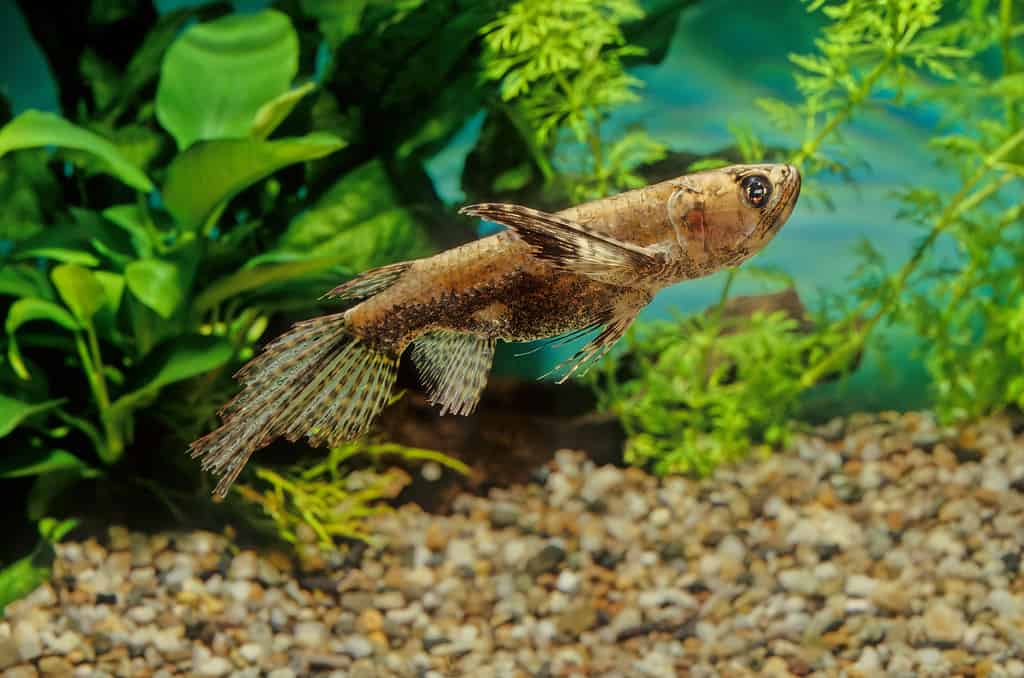
The freshwater butterflyfish or African butterflyfish is a unique fish species.
©Miropa/iStock via Getty Images
The African butterflyfish is undeniably a stunning choice to accompany crayfish in a freshwater tank.
This fish boasts a distinct flat top and a broad body, complemented by fins that fan out gracefully beneath the water’s surface. When viewed from above, its expansive pectoral fins give an impression similar to butterfly wings, hence the name.
In captivity, the African butterflyfish typically grows to a size of around 4 inches. For their well-being, a spacious, shallow tank filled with aquatic plants is ideal.
A fascinating behavior of this species is its knack for mimicry. It often disguises itself as a fallen leaf or debris floating on the water’s surface. This clever tactic not only makes them an intriguing spectacle but also keeps them mostly out of the reach of crayfish. Given their mature size, they are usually safe, even if adventurous crayfish attempt to ascend plants towards the surface.
However, it’s worth noting that smaller young butterflyfish in a densely planted environment might occasionally fall prey to an ambitious crayfish.
6. Zebrafish (Danio rerio)
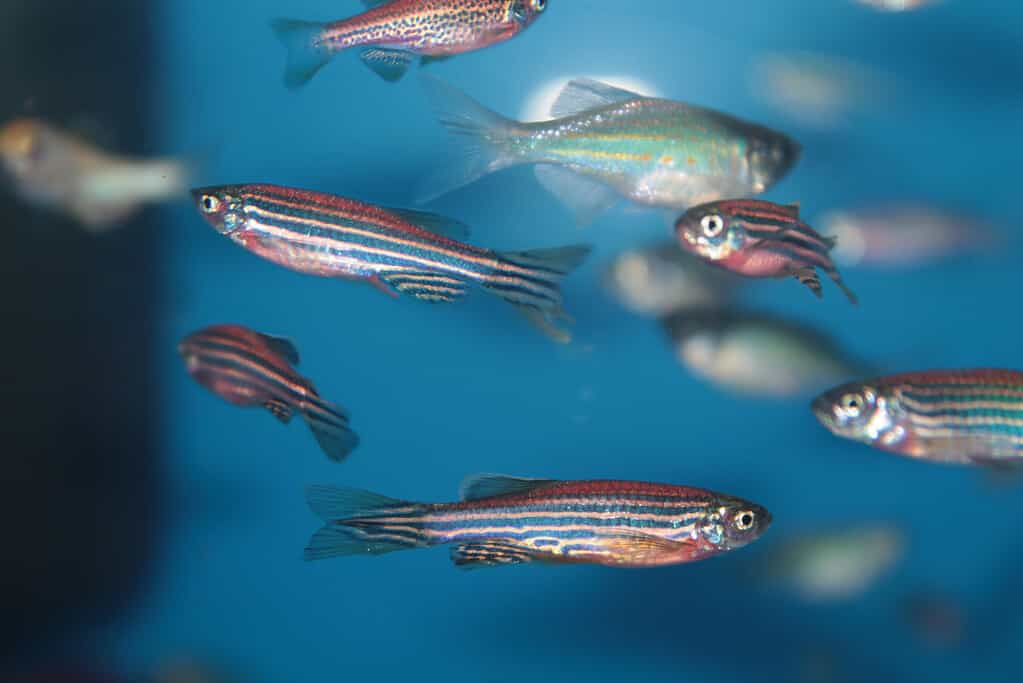
These striped fish are excellent companion fish for a crawfish tank.
©kazakovmaksim/iStock via Getty Images
Zebrafish make a visually appealing addition to a tank shared with crayfish.
The males are adorned with alternating blue and golden stripes, while the females showcase shimmering silver lines. Boasting a sleek, compressed body, these fish have a distinct upward-facing mouth. Typically, a zebrafish grows to a size between 1.6 and 2.0 inches.
For their comfort and active swimming habits, housing them in a tank of at least 10 gallons is advisable, with larger spaces being even more beneficial. It’s essential to maintain clean, oxygen-rich water for them, so incorporating a filter is a good idea.
Their dietary preferences don’t overlap with crayfish, reducing the risk of food theft. Their fast swimming speed and tendency to stay near the surface keep them relatively safe from any lurking crayfish below.
However, zebrafish might sometimes be drawn to the tank’s cooler bottom regions, putting them closer to potential crayfish encounters.
7. White Cloud Mountain Minnow (Tanichthys albonubes)

White cloud mountain minnows add a dash of color to your freshwater tank.
©Besjunior/Shutterstock.com
A favorite among aquarists due to their adaptability to varying temperatures, these swift swimmers make a splendid contrast to the slow pace of crayfish.
White cloud mountain minnows shine with a silver-green hue complemented by radiant red fins and tails. Their hardy nature and ease of breeding have earned them a reputation as an excellent choice for beginners. These fish typically grow to about 1.5 inches in length.
It’s best to house these minnows in groups, ideally six or more, as they thrive in schools. Although they can handle a range of temperatures, they might feel stressed in overly warm waters. Interestingly, they can comfortably reside in tanks without heaters.
Their agility usually keeps them out of crayfish’s reach, and they’re cost-effective to replace. On the flip side, they don’t stay strictly near the surface, so a weakened or sick minnow might occasionally fall within a crayfish’s grasp.
8. Giant Danios (Devario aequipinnatus)
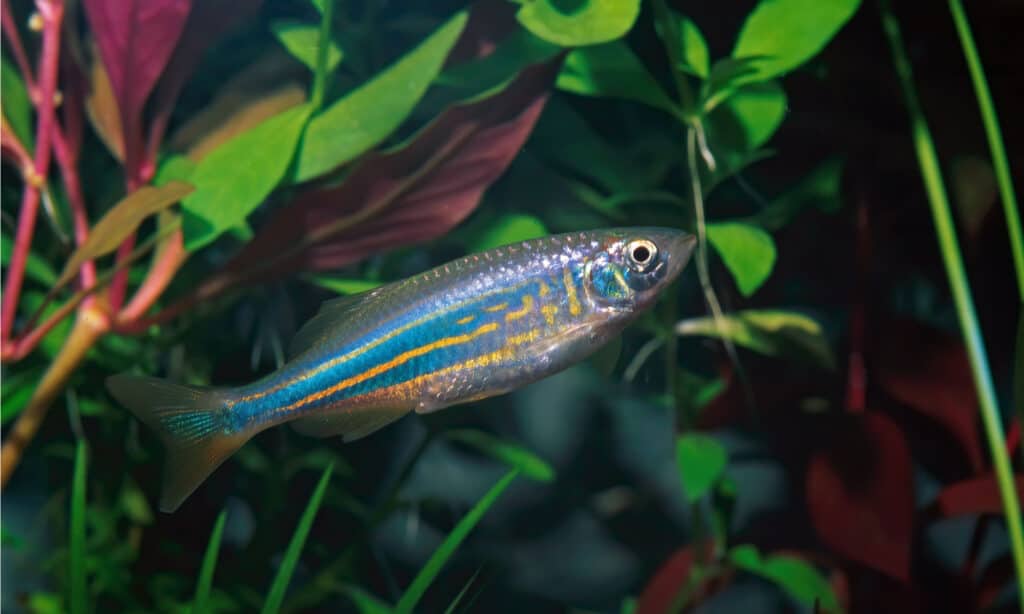
Danios are tropical fish that belong to the minnow family.
©Karel Zahradka/Shutterstock.com
Though giant danios aren’t as common among hobbyists, they are still relatively accessible.
Despite being called “giants,” giant danios only measure around 4 to 6 inches when fully grown. Their golden shimmering bodies are adorned with steel-blue patterns that extend from their gills to their forked tail fins. The rest of their fins exude a soft golden hue.
These fish prefer environments that mirror their natural, pristine freshwater habitats. Despite their robust nature, they aren’t immune to typical fish diseases, such as ich.
Their size means they don’t easily get intimidated by crayfish, and their speed ensures they can dodge any potential threats, even during their younger days. Remarkably, there don’t appear to be any significant downsides to keeping them alongside crayfish in a freshwater tank!
9. Silver Dollar (Metynnis argenteus)

Silver dollar fish are peaceful fish with elongated flat bodies.
©You Touch Pix of EuToch/Shutterstock.com
If you’re looking for an ideal tank mate for your crayfish, the silver dollar fish might be a perfect choice.
These fish feature round, flattened bodies and are notably deep-bodied. On average, they attain a size of around 6 inches. Their primary shade is metallic silver, but under certain lighting, subtle shades of green and blue can be spotted. Distinguishing between males and females is challenging as they bear striking resemblances.
Silver dollars thrive in soft, slightly acidic water, but they’re generally adaptable to varying water conditions. For optimal health and vibrancy, it’s advisable to house them in transparent, well-aerated water with effective filtration and good circulation.
Introducing this sizable fish to your tank not only adds a delightful visual contrast but also provides them with a size advantage against even the most aggressive crayfish. However, the need for a spacious tank is a potential drawback.
10. Bala Shark (Balantiocheilos melanopteru)
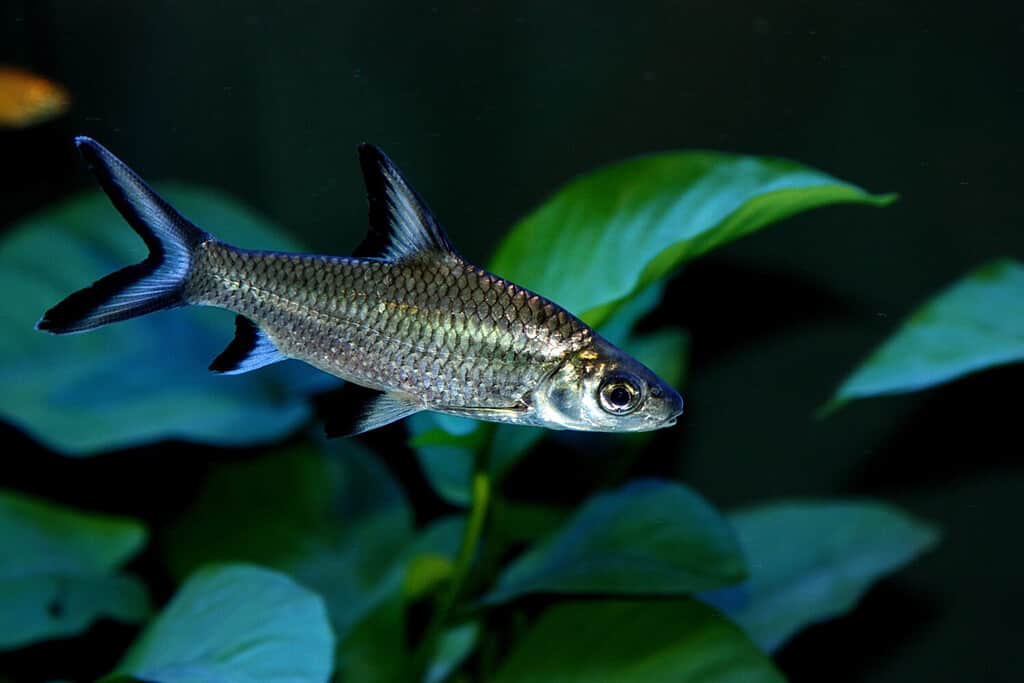
The bala shark is not actually a shark but a small freshwater fish.
©Arunee Rodloy/Shutterstock.com
Bala sharks are large fish that are a suitable choice for cohabiting in a tank with crayfish.
Sporting a metallic silver color, these fish come with distinct scales, pronounced eyes, and a prominently forked tail that has a hint of yellow. Their dorsal, tail, pelvic, and anal fins are strikingly outlined in black. They can grow impressively, often exceeding lengths of 10 to 12 inches.
For adult bala sharks, it’s best to provide a spacious tank, ideally 150 gallons or more, spanning at least 5 feet in width. This ensures the active, mid-level swimmer has ample room to swim around.
These fish stand out with their vivid colors and spirited demeanor. But it’s essential to note that catering to their needs, both in terms of space and diet, can be somewhat costly. This makes them a bit challenging to care for.
Their agility in water allows them to easily dodge crayfish, and as they mature, their size offers an added layer of safety against any potential crayfish threat.
11. Least Killifish (Heterandria formosa)
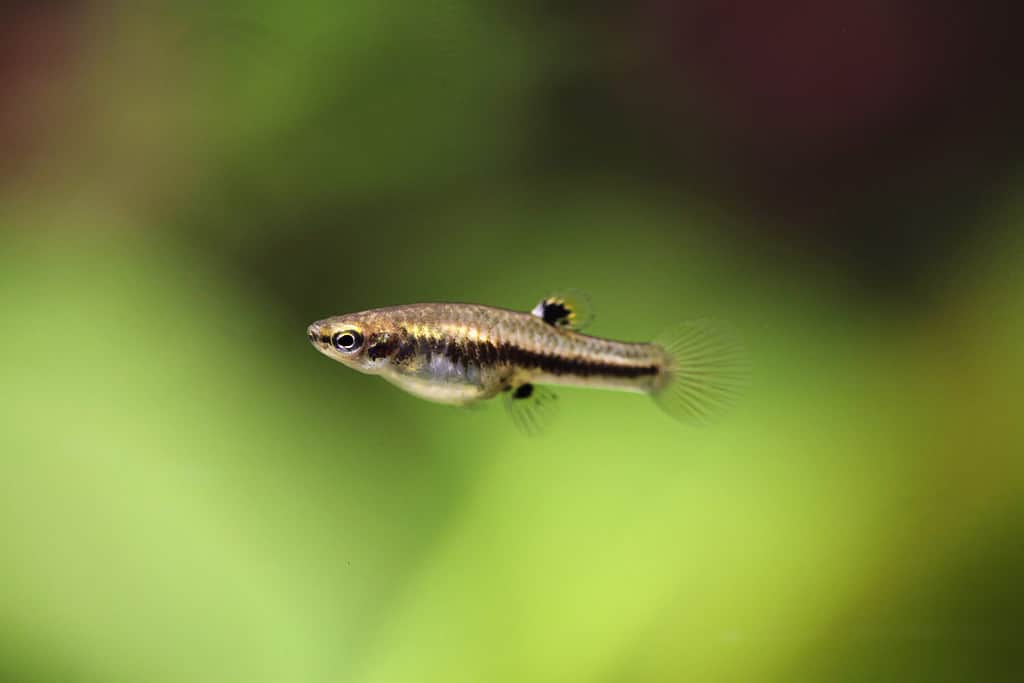
This tiny fish is one of the smallest in the world and makes great tank mates for crayfish.
©Vladimir Wrangel/Shutterstock.com
The dwarf mosquitofish, often referred to as the least killifish, is among the smallest fish species globally.
This fish has a compact body, a subtly upward-facing mouth, and a rounded tail fin. One of its distinct features is a dark line that runs from its nose to its tail fin, accompanied by subtle bars that sometimes stretch upward or even toward its midsection. These fish are insanely small typically only measuring between 0.5 and 1.2 inches when fully grown.
For the comfort of a least killifish, slow-moving waters are ideal. A gently bubbling sponge filter can help replicate their preferred environment, especially in small tanks.
Their habit of staying near the water’s surface means they’re less exposed to any potential threats from below. Feeding them might require a tad more effort due to their micro-predatory nature. But if you’re up for the task, they can make a delightful addition to your aquatic setup with crayfish.
12. Neon Tetra (Paracheirodon innesi)
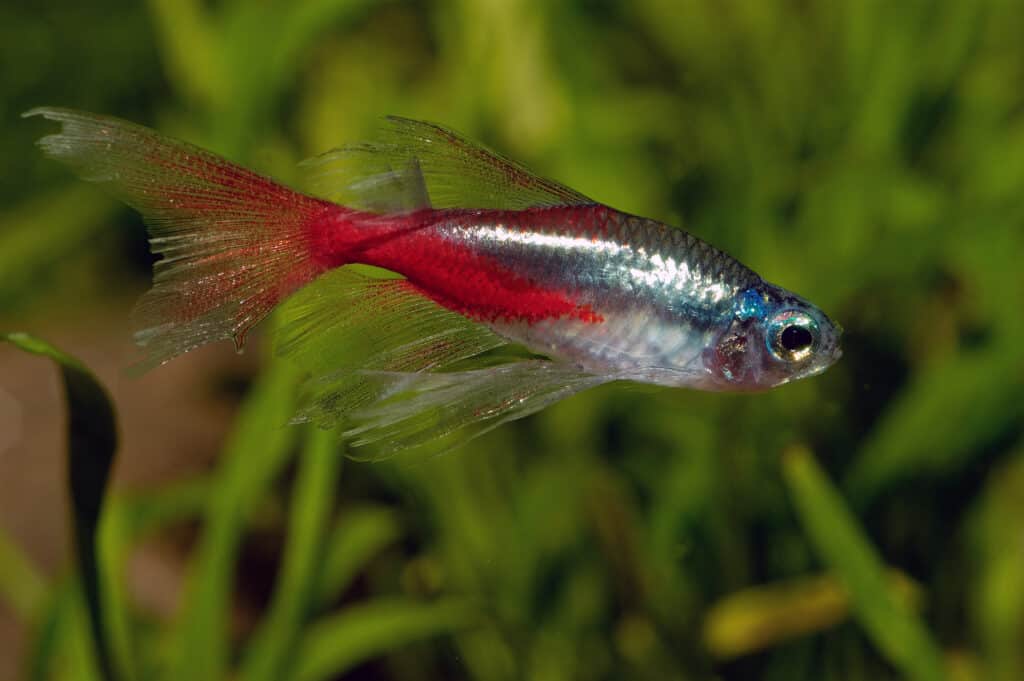
A favorite species in many tropical freshwater aquariums, neon tetras are beautiful fish.
©NERYXCOM/Shutterstock.com
Neon tetras are undeniably iconic in the world of aquarium enthusiasts. Their widespread popularity means they’re easily found in most places selling freshwater fish.
Characterized by a soft blue hue on their back and a sparkling silver belly, neon tetras are most recognized for the dazzling red stripe that graces the center of their body. They typically grow up to 1.5 inches, and there’s a new variant that flaunts long fins.
Neon tetras require a warm water temperature of between 62 to 82 degrees F. So, for their comfort, consider an aquarium heater. Given their preference for gentle currents, we also recommend using a soft sponge filter. If you’re using other filtration systems, a pre-filter sponge can ensure they remain safe from strong water suction.
These fish are the perfect choice for a tank mate to check crayfish’s temperament, and their speed might help them to evade crayfish as well. However, it’s worth noting that their occasional ventures to the tank’s bottom might expose them to crayfish encounters. Fortunately, if there’s a loss, replacements are readily available.
13. Tiger Barb (Puntigrus tetrazona)

Growing between 2.8 and 3.9 inches,
tiger
barbs are medium-sized aquarium fish.
©Pavaphon Supanantananont/Shutterstock.com
Tiger barbs bring an exotic, vibrant touch to your aquarium and when in groups, have a good track record of coexisting with crayfish.
These barbs are available in captivating colors like gold, green, red, and black. Their distinct vertical bands, reminiscent of tiger stripes, inspire their name. A fully grown tiger barb can measure between 2.8 to 3.9 inches in length and 1.2 to 1.6 inches in width.
To accommodate their dynamic nature, it’s best to house them in tanks of 29 gallons or more, adorned with ample aquatic plants and decorative elements. However, due to their occasional feisty behavior and tendency to nip at long-finned tankmates, tiger barbs might not be the perfect fit for every community tank.
They can add a splash of color to tanks, even those housing blue crayfish. When adequately fed, they generally evade the grasp of crayfish. However, it’s essential to ensure regular feeding, as a hungry crayfish might view them as potential prey.
14. Marbled Hatchetfish (Carnegiella strigata)
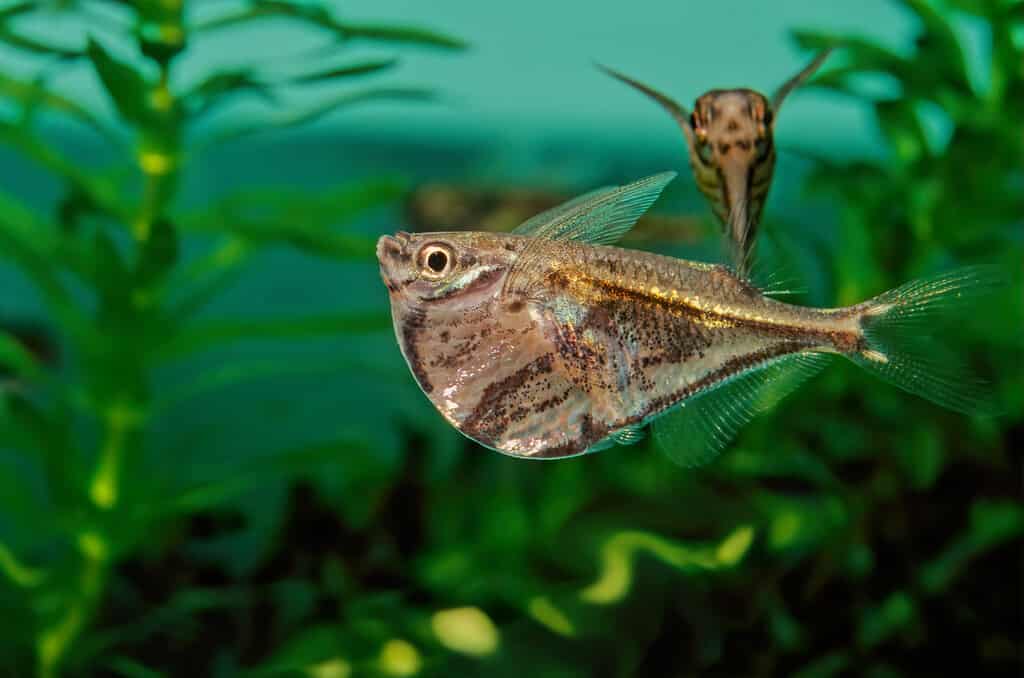
This unique species is sure to be a conversation starter.
©Miropa/iStock via Getty Images
The marbled hatchetfish is a prime choice when considering tank mates for crayfish.
This small freshwater fish, usually measuring around 1.4 inches, boasts a unique hatchet shape. A striking gold line extends from its eye to its tail fin. Below this line, the fish displays a blend of brown and cream hues, creating a marbled appearance, which inspired its name.
For the marbled hatchetfish to flourish, soft and acidic water conditions are ideal. Utilizing peat filtration can be beneficial.
One of the primary reasons this fish does well with crayfish is its habit of sticking to the water’s surface. This behavior significantly reduces its risk of becoming a crayfish’s meal compared to other potential tank inhabitants.
However, caring for hatchetfish comes with its drawbacks. They’ll only consume food floating on the water’s surface. Any food that descends is generally ignored, so it’s crucial to provide food that remains afloat to ensure they’re well-fed.
15. Harlequin Rasbora (Trigonostigma heteromorpha)
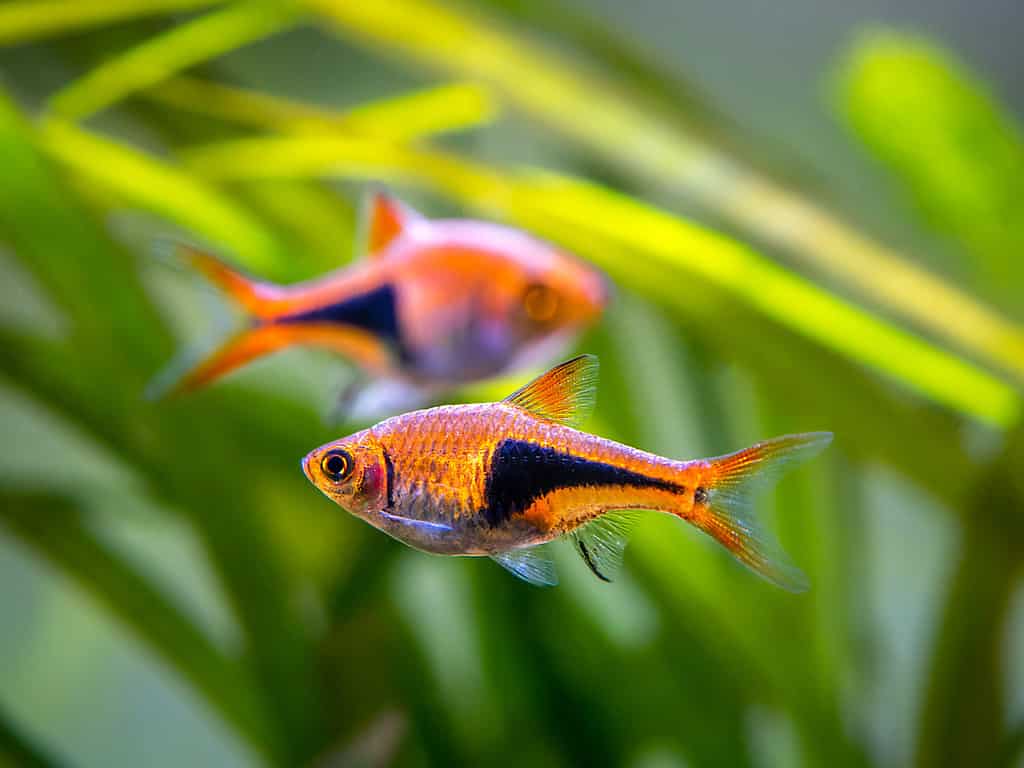
This brightly colored fish is a popular tropical aquarium species.
©Joan Carles Juarez/Shutterstock.com
Harlequin rasboras are colorful and favored by many aquarium enthusiasts.
Among the numerous rasbora species, harlequins stand out as a top choice. They’re sometimes called red rasboras due to their deep reddish hue. A bold black triangle on the latter part of their body makes them even more distinctive. These fish can reach a size of 2 inches.
It’s essential to maintain their water temperature between 72 to 81°F since they thrive in warmer waters. So, an aquarium heater may be necessary.
They usually swim in the upper and middle sections of a tank. This behavior keeps them out of a crayfish’s reach, and their active nature and quick movements further protect them from threats. This means that crayfish and Harlequin rasboras make excellent tank mates.
it’s crucial to avoid placing tall plants or ornaments near the aquarium‘s base. Crayfish can climb these structures to access fish that would usually be out of their reach.
16. Redtail Shark (Epalzeorhynchos bicolor)
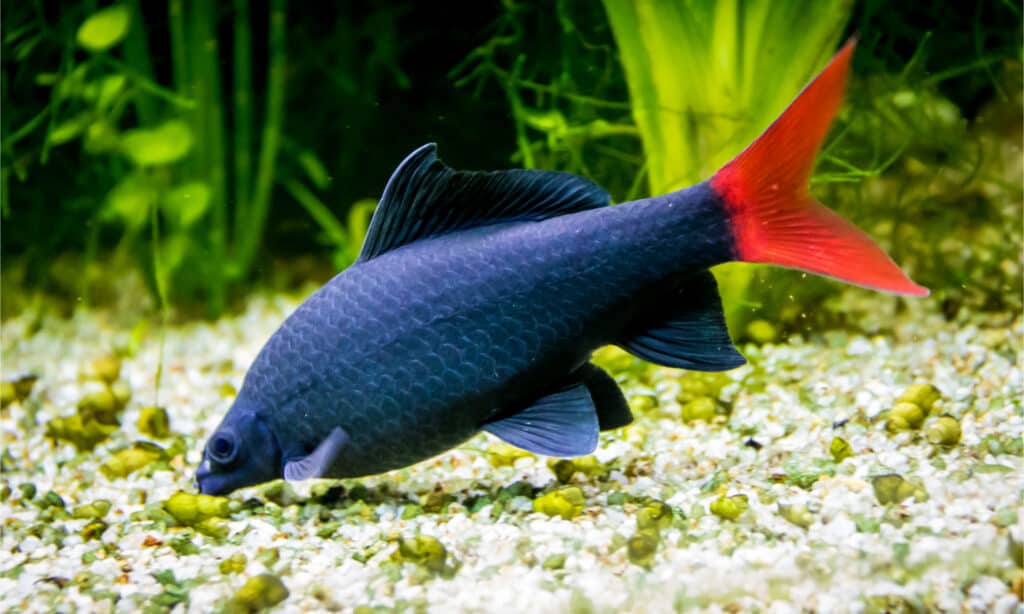
Red tail sharks are interesting fish that make great tank mates with crayfish.
©iStock.com/diegograndi
Last but not least, the redtail shark is probably one of the best tank mates to pair with crayfish!
These sharks are easily recognizable with their dark bodies contrasted by vibrant red tails. They have a slender shape, distinct triangular fins, and nearly see-through pectoral fins. Interestingly, their rounded pelvic fins are positioned closer to their tails than most other fish.
A typical redtail shark can grow up to 6 inches, but some even reach lengths of 7 or 8 inches.
They need spacious surroundings. A tank of at least 29 gallons is recommended initially, but as they grow, they’ll be more comfortable in a 55-gallon environment, preferably with other moderately aggressive fish.
If you’re looking for another species that stays at the bottom of the tank alongside your crayfish, the redtail shark is a solid pick. Make sure the shark is larger than the crayfish when introducing them.
Although redtail sharks can be territorial, providing them with a cave will help. This gives them a sense of territory, making cohabitation with crayfish smoother. Plus, these sharks are aggressive and can handle themselves if challenged.
Summary of Ideal Tank Mates to Pair with Crayfish
| Tank Mate | Temperament | Average Lifespan |
|---|---|---|
| Brown Pencilfish | Very Timid | 5 years |
| Forktail Blue-Eye | Peaceful | 2-3 years |
| Golden Panchax | Peaceful (may eat small fish) | 5 years |
| Wrestling Halfbeak | Peaceful | 4 years |
| African Butterflyfish | Semi-aggressive | 5-6 years |
| Zebrafish | Peaceful | 3 years |
| White Cloud Mountain Minnow | Peaceful | 5-7 years |
| Giant Danios | Peaceful | 5-7 years |
| Silver Dollar | Peaceful & timid | 10 years |
| Bala Sharks | Peaceful | 10 years |
| Least Killifish | Peaceful | 1.5 years |
| Neon Tetra | Peaceful | 10 years |
| Tiger Barb | Semi-aggressive | 5-7 years |
| Marbled Hatchetfish | Peaceful & timid | 2-5 years |
| Harlequin Rasbora | Peaceful | 5-8 years |
| Red Tail Shark | Aggressive & territorial | 5-8 years |
Disclaimer: While certain fish are deemed compatible with crayfish, their predatory tendencies can still pose a risk. With crayfish interactions, outcomes are never fully predictable. Always monitor your tank for the safety of its inhabitants.
The photo featured at the top of this post is © Miropa/iStock via Getty Images
Thank you for reading! Have some feedback for us? Contact the AZ Animals editorial team.






